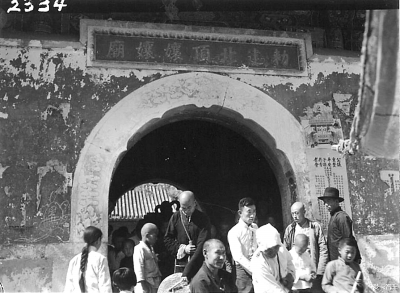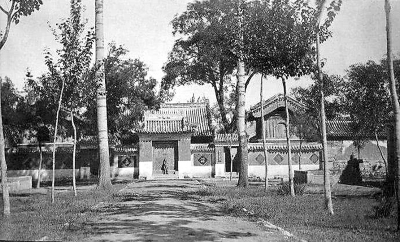Niangniang Temple’s "Shopping Festival"
Original title: Niangniang Temple’s "Shopping Festival"

At the entrance of Niangniang Temple in Beiding, there are notices of various incense parties and graffiti of children on the wall, which is full of life.

The little girl is picking out toys at the temple market of Niangniang Temple in Beiding.

In 1930s, the Puji Palace was in the middle of the building outside You ‘anmen. Pictures are provided by Tao Ran Yelao and Gao Shen.
After the commodity exchange of production development appeared, it was indispensable for buy buy to buy. Nowadays, the savvy "pickpocket party" must pay attention to shopping festivals such as "Double Eleven" and "Anniversary Celebration" when spending online and offline, and buy all the big items and small items at once. In the past, there was no online shopping or big shopping malls. Where did old Beijing go to find goods? When is the shopping festival? There is no doubt that it is a temple city.
Temple fair is a religious activity that the temple is open to the public, but besides praying to God and worshiping Buddha, buying daily necessities is also a major function of the temple fair. Clothing, shoes, hats, pots and pans, children’s toys, and daily necessities are all available from temple fairs. While shopping, you can also listen to cross talk, watch acrobatics and have some snacks, which can be described as a one-stop service for traveling, entertainment and purchase. The market held regularly by temple fairs also came into being, and it was called "temple market".
There are many temples in old Beijing, so there are naturally many temples in the city. There are dozens of famous temple cities in old Beijing, such as Chenghuang Temple, Dongyue Temple, Huguo Temple, Longfu Temple, Baiyunguan Temple, Changdian, Flower Market, Flat Peach Palace and "Five Top" Niangniang Temple. In terms of purchasing power, women are undoubtedly the biggest financiers of businesses, and the Niangniang Temple, which is sought after by women, stands out and becomes a battleground for businesses.
The "Five Top" Niangniang temples in Beijing are all built on the flat ground, but they are called the "Top" in a serious way. In fact, this is a folk imagination of "a fairy makes a name": Bixia Yuanjun enshrined in the temple is a goddess of Mount Tai, and her temple must be a castle in the fairy mountain. The "Five Tops" ring is listed around the capital, and both are in the urban-rural fringe, which naturally becomes an important commodity distribution center.
The temple market of Niangniang Temple in Beiding is opened from the first day of April to the fifteenth day of the lunar calendar. The commodities are mainly agricultural tools for daily use, and farmers from Changping and Shahe will come here to exchange materials. In order to gather popularity, every time the market opens, there will be a stage singing in front of the temple, and the troupe will be invited to be lively for a few days. Straw hats, flower baskets, etc., woven with wheat straw, are famous specialties here, and buyers are mostly suburban farmers.
Beiding was just busy, and from the first day to the seventh day of the fifth lunar month, the temple market of Niangniang Temple in Dongding was opened again. During the temple market, merchants gathered on both sides of Dongba main street and Niangniangmiao street, and department stores were mixed. On the first day of May, there are lion dancers at the northwest gate of Dongba and stilts in Gaobeidian. The people in Sanhe and Jixian counties all arrived overnight by train, which shows how prosperous the temple market is.
Zhongdingmiao City didn’t open until June of the lunar calendar at the latest. There was an ancient poem that said: "There is little dust outside the You ‘anmen Gate, and the figure smells like early rice. After Xiao Yufang opened the market, he sat on the top of the altar and made incense." At that time, there were many kinds of folk flower shows, such as the Five Tigers, Shaolin, Zhongfan, etc., and it was the only place where the traditional program "Thirteenth Flower Show" was performed.
Manjuji is on the only way to Xiding, and Xiding is followed by at the manjuji Temple Fair every year. There is a unique two-part allegorical saying in old Beijing: "manjuji bends down-see you at the top", which means that the two temple fairs in Xiding Niangniang Temple and manjuji are in the same period, and they are only seven or eight miles apart. After the acquaintances who are in a hurry in manjuji meet each other, they just bow their hands and wait until Xiding Niangniang Temple makes a pilgrimage before sitting down and chatting.
Nanding is divided into two temples: Da Nanding and Xiao Nanding. Before the rise of Miaofengshan Temple Fair, among many Niangniang Temple Fairs, several Nanding temples were the largest. Later, the small Nanding on the south extension line of the central axis of Beijing gradually replaced the big Nanding, which became a favorite place for vendors in the south of the city.
Xiaonanding outside Yongdingmen is not far from the city, and the area is open and the water plants are rich. The horse racing that prevailed in the late Qing Dynasty and the early Republic of China was held here. Later, horse racing was banned by the government because of the disorder and the impact on the traffic in Yongdingmen, but the resulting snack street has become a climate.
When the scenery of the "Five Tops" is infinite, each top has a temple market with different characteristics: the top is dominated by social fire and walking; Nanding is famous for its sports cars and horse racing. Xiding is the place where the empress dowager celebrates her birthday; Beiding and Dongding are big wholesale markets.
In addition to the "Five Peaks", there is also a "Golden Peaks". At the end of the Qing Dynasty and the beginning of the Republic of China, Miaofengshan Temple Fair was the largest temple fair in North China, and incense clubs provided various free services for pilgrims. Although pilgrims don’t need to spend money, villagers in Shanzhong Village still call this temple fair "Miaoqiu". Like the autumn harvest, it is a good opportunity to make a fortune.
Women weave straw hats, round fans, flower baskets and various toys such as flowers, birds, fish and animals with wheat straw; Men go to the mountains to cut some peach branches and chop them into crutches or handicrafts two or three feet long. When the temple period is over, it will be sold out for pilgrims to buy. Pilgrims rushed to buy for good luck, and the villagers made ten times the profit.
These Niangniang Temple markets, with fixed time and different places and patterns, make people happy to buy and spend, which is really a shopping festival that never ends.
(Gao Shen Sun Wenzhao)